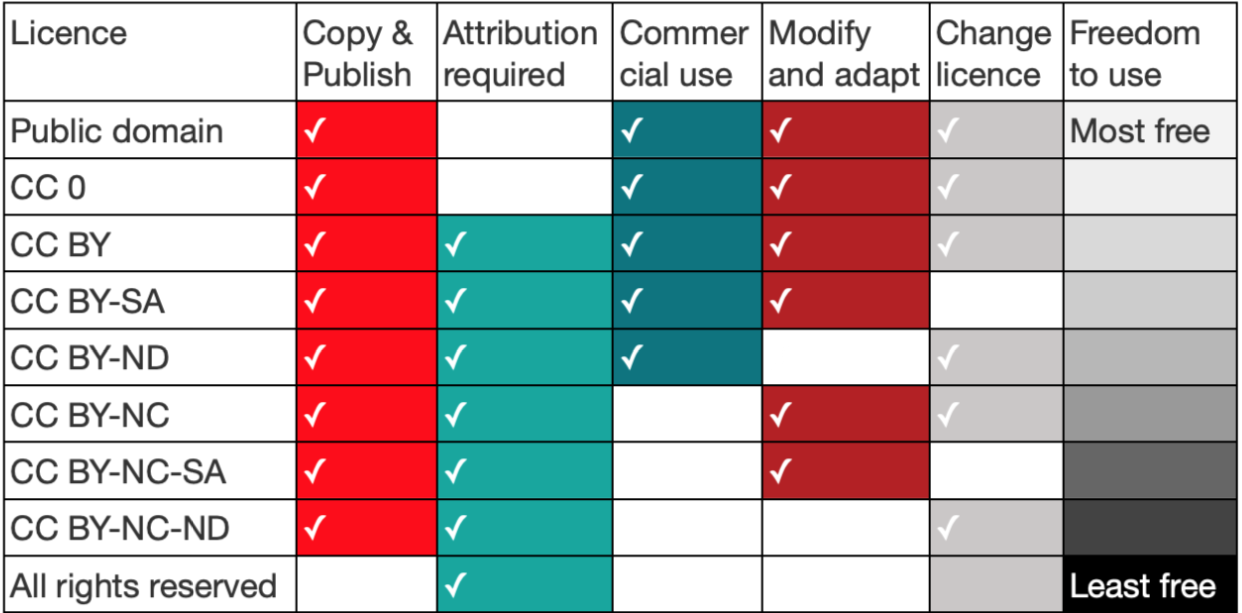Selecting a licence for educational resources

Technology themes in an abstract flat illustration. Components of both mobile and online software. Generative AI Von 2ragon, downloaded from Adobe stock, 578675781
The “All Rights Reserved” approach grants the copyright holder exclusive rights over their work, meaning that others need explicit permission to use, copy, distribute, or modify it. Creative Commons licenses allow creators to retain their copyright while granting permissions to others to use, share, and build upon their work.
All rights reserved: You retain all rights provided by copyright law. As such, another person cannot reproduce, distribute and/or adapt any part of the work without your permission.
Public domain: Content is not licenseable, or work is dedicated to the public domain.
CC0: Content is licensable, creator or copyright holder waives their rights.
CC licences are valid for content that is licenseable, and copyright is with the creator or with someone that acquired the copyright from the creator. The copyright holder can use a CC licence to grant users the right to view, modify and share their original and derivative works. The following limitations can be placed upon a CC licence:
BY: you must give appropriate credit to the original work, provide a link to the licence, and indicate if changes were made.
SA: If you remix, transform, or build upon the material, you must distribute your contributions under the same licence as the original. The parts of the new work that are stemming from – or derivatives of – the original work have to be shared under the same licence. New, independent works that are added to but not combined with original works do not have to be shared under the same licence. For example, including a video with a CC-BY-SA licence in your mediaspace video channel means you have to attribute the original work and share this video under the same licence but doesn’t require you to share your other videos under the same CC-BY-SA licence.
ND: The users can not recombine or edit your content, only share it as it is. This means that other users can’t subtitle videos, translate or edit your work.
NC: The users can’t share your works though any media or channels that may be considered commercial, or use your works for commercial purposes, or use your works in any commercial context. The “commercial use” is not universally defined, and differs for different legal contexts.
Overview

Recommendation
In line with EPFL’s commitment to promoting open science and facilitating the unrestricted sharing of ideas, we advise opting for an open license, preferably CC0, CC BY, or CC BY-SA. It’s worth noting that the CC BY-SA license does impose certain limitations on users.
While there may be rare instances where an ND (NoDerivatives) license is necessary, such as when individuals featured in a video do not grant permission for such a license, it’s important to recognise that this license also restricts translation, addition of subtitles, or editing. Therefore, we do not recommend utilizing this license.
The selection of the NC (NonCommercial) license is often based on the belief that works created using public funds should not be monetized. However, it is important to note that while certain grants may impose such conditions, they typically apply only to the original works and not to derivatives. It is not advisable to utilise this restriction, due to varying interpretations of commercialisation in different legal contexts (countries) and potential limitations on publishing through academic platforms, with publishing houses deemed commercial, or use of your content by or within private organisations that serve both the public domain and have a commercial mission.
More information
Basics of Copyright in Switzerland: https://www.ccdigitallaw.ch/introduction/ With in chapter 5 information on “right to quotation” and “private use” when using third-party copyrights.
How to label third party content in your CC licensed materials: https://smartcopying.edu.au/how-to-label-third-party-content-in-creative-commons-licensed-material/
The FAQ page of Creative Commons: https://wiki.creativecommons.org/wiki/Frequently_Asked_Questions#How_do_I_properly_attribute_a_Creative_Commons_licensed_work.3F
